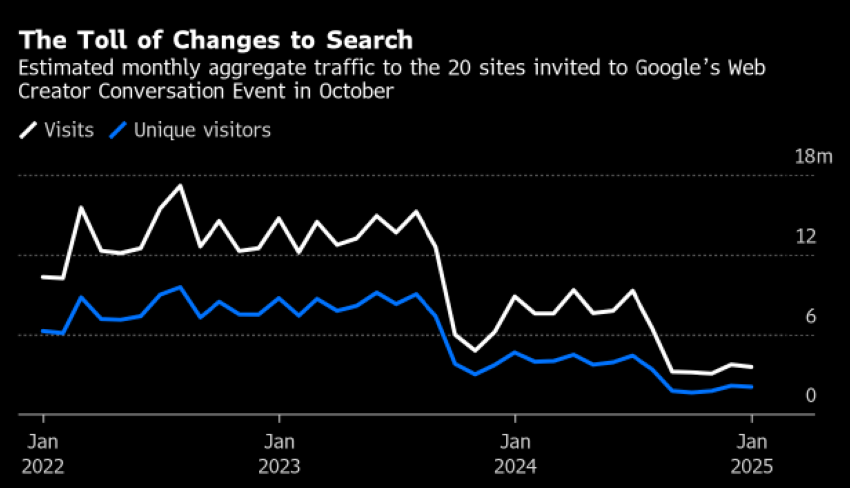TL;DR: How AI Summaries Are Impacting Traditional Website Usage
August 28, 2025

Since its launch in November 2022, ChatGPT has grown from one million weekly users to 800 million as of May 2025, with the goal of surpassing one billion by the end of this year.1 The rapid growth of artificial intelligence (AI) users, as well as the AI-generated summaries that now appear after Google searches, have changed how people search for information and use the internet. Quick, organized bullet points on topics are replacing the need to endlessly click and scroll through websites to find information. While ChatGPT and Google AI often include sources and website links in their answers, that does not always translate to increased traffic for the referenced websites. The prevalence of AI usage is causing websites, especially news related sites, to lose clicks to their articles. According to SimilarWeb, a website tracking database, news searches that resulted in the user not clicking through to the actual source increased from 56% in May 2024, when Google first launched its AI summaries, to nearly 69% as of May 2025.2 Additionally, organic traffic to news sites fell to approximately 1.7 billion from a peak of over 2.3 billion in mid-2024.3 This decline is occurring despite ChatGPT referring users to news sites, as trends suggest that users may be using the platform for deeper research, rather than quick clicks.
While users value a platform that streamlines questions and research through scraping the web and data for answers, news sites and advertisers feel a growing sense of alarm, as people seem to be shifting away from scrolling on sites for news. Executives at news publications are bracing for the worst, with Chief Executive Officer Nicholas Thompson of the Atlantic saying to assume traffic from Google would drop toward zero and the company needed to evolve its business model, while the Washington Post prepares for a “post-search era.”4 Similarly, website advertisers who rely on users scrolling through articles and seeing or interacting with embedded advertisements, are experiencing slowdowns or declines in growth as user traffic declines.
Key Takeaway
Users are moving away from search engines and toward “answer engines” that source and compile information in an easily readable format. This shift in the way users consume information may cause devastating effects on news sites and web-based advertisers. As companies were forced to adapt to the transition away from physical newspapers, they will again have to evolve to overcome users’ desire for summarized answers instead of long-form articles, whether through finding ways to monetize AI’s use of their data or finding innovative ways to bring back user engagement. This has been a key focus in the technology, media, telecommunications and advertising sectors. It will be crucial for investors to understand the long-term implications of AI usage on companies and focus on news and advertising companies that can effectively navigate a changing user experience.
Sources:
1Exploding Topics – Number of ChatGPT Users (July 2025); 8/18/25
2,3New York Post – Google AI summaries increase frequency of ‘zero clicks’ to search results, sinking traffic to news sites: report; 7/3/25
4The Wall Street Journal – News Sites Are Getting Crushed by Google’s New AI Tools; 6/10/25
This material is for informational use only. The views expressed are those of the author, and do not necessarily reflect the views of Penn Mutual Asset Management. This material is not intended to be relied upon as a forecast, research or investment advice, and it is not a recommendation, offer or solicitation to buy or sell any securities or to adopt any investment strategy.
Opinions and statements of financial market trends that are based on current market conditions constitute judgment of the author and are subject to change without notice. The information and opinions contained in this material are derived from sources deemed to be reliable but should not be assumed to be accurate or complete. Statements that reflect projections or expectations of future financial or economic performance of the markets may be considered forward-looking statements. Actual results may differ significantly. Any forecasts contained in this material are based on various estimates and assumptions, and there can be no assurance that such estimates or assumptions will prove accurate.
Investing involves risk, including possible loss of principal. Past performance is no guarantee of future results. All information referenced in preparation of this material has been obtained from sources believed to be reliable, but accuracy and completeness are not guaranteed. There is no representation or warranty as to the accuracy of the information and Penn Mutual Asset Management shall have no liability for decisions based upon such information.
High-Yield bonds are subject to greater fluctuations in value and risk of loss of income and principal. Investing in higher yielding, lower rated corporate bonds have a greater risk of price fluctuations and loss of principal and income than U.S. Treasury bonds and bills. Government securities offer a higher degree of safety and are guaranteed as to the timely payment of principal and interest if held to maturity.
All trademarks are the property of their respective owners. This material may not be reproduced in whole or in part in any form, or referred to in any other publication, without express written permission.

